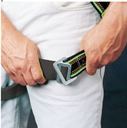Personal Fall Arrest Design Flaw
There is a long-standing design flaw in many personal fall arrest harnesses. This design is used by several major manufacturers of harnesses for fall arrest and by at least one manufacturer of mountaineering harnesses.
 The flaw is in the mating plate buckle, also called a pass-through buckle or qwik-fit buckle. This buckle is easy to adjust and allows the top plate to be turned and passed through the mating plate for easy removal of the harness.
The flaw is in the mating plate buckle, also called a pass-through buckle or qwik-fit buckle. This buckle is easy to adjust and allows the top plate to be turned and passed through the mating plate for easy removal of the harness.
When the harness is loaded with weight, the weight of the user pulls the top plate by the leg strap so the adjusting end of the harness webbing is pinched between the plates, preventing the harness from loosening.
 The flaw is that the user may fasten the top plate reversed, enabling the leg harness to easily be pulled loose. This is very subtle, so it is easily overlooked by the user.
The flaw is that the user may fasten the top plate reversed, enabling the leg harness to easily be pulled loose. This is very subtle, so it is easily overlooked by the user.
I am a rock climber by avocation and a high angle rescue team member and industrial safety advisor for an electric utility, so I'm familiar with different harness designs. This came to my attention when I noticed workers putting their harnesses on after lunch break. Much of the time, the top plate on the leg loops was reversed when the user refastened the buckle.
 Several manufacturers were notified of this flaw, and at least two of them did drop tests of dummies to see whether the harness leg loops will slip. The results were good: little or no slippage. However, these tests were done with new harnesses, with the leg straps pulled tightly and the plastic keeper loop in place. The friction of the webbing strap against the dummy's leg held the strap in place.
Several manufacturers were notified of this flaw, and at least two of them did drop tests of dummies to see whether the harness leg loops will slip. The results were good: little or no slippage. However, these tests were done with new harnesses, with the leg straps pulled tightly and the plastic keeper loop in place. The friction of the webbing strap against the dummy's leg held the strap in place.
Experience in the field has demonstrated that the harness webbing becomes much more flexible with use, the users often leave leg straps loose for comfort, and often the plastic keeper loop is missing or does not have the end of the adjustable webbing through it.
If you hold the harness in your hands and pull against the leg loop with the top plate reversed, you will see how easily the buckle slips.
What are some possible solutions? The manufacturer or purchaser could mark the buckle so that it is apparent when it is fastened wrong. This information should be included in an organization's training on the use of personal fall arrest equipment.
This is a convenient and, when properly fastened, safe design. However, if fastened wrong, it could allow a user to be injured in the event of an arrested fall.
Robert Peterson ([email protected]) is an industrial trainer in Rockford, Ill.
Posted by Robert Peterson on Feb 17, 2014